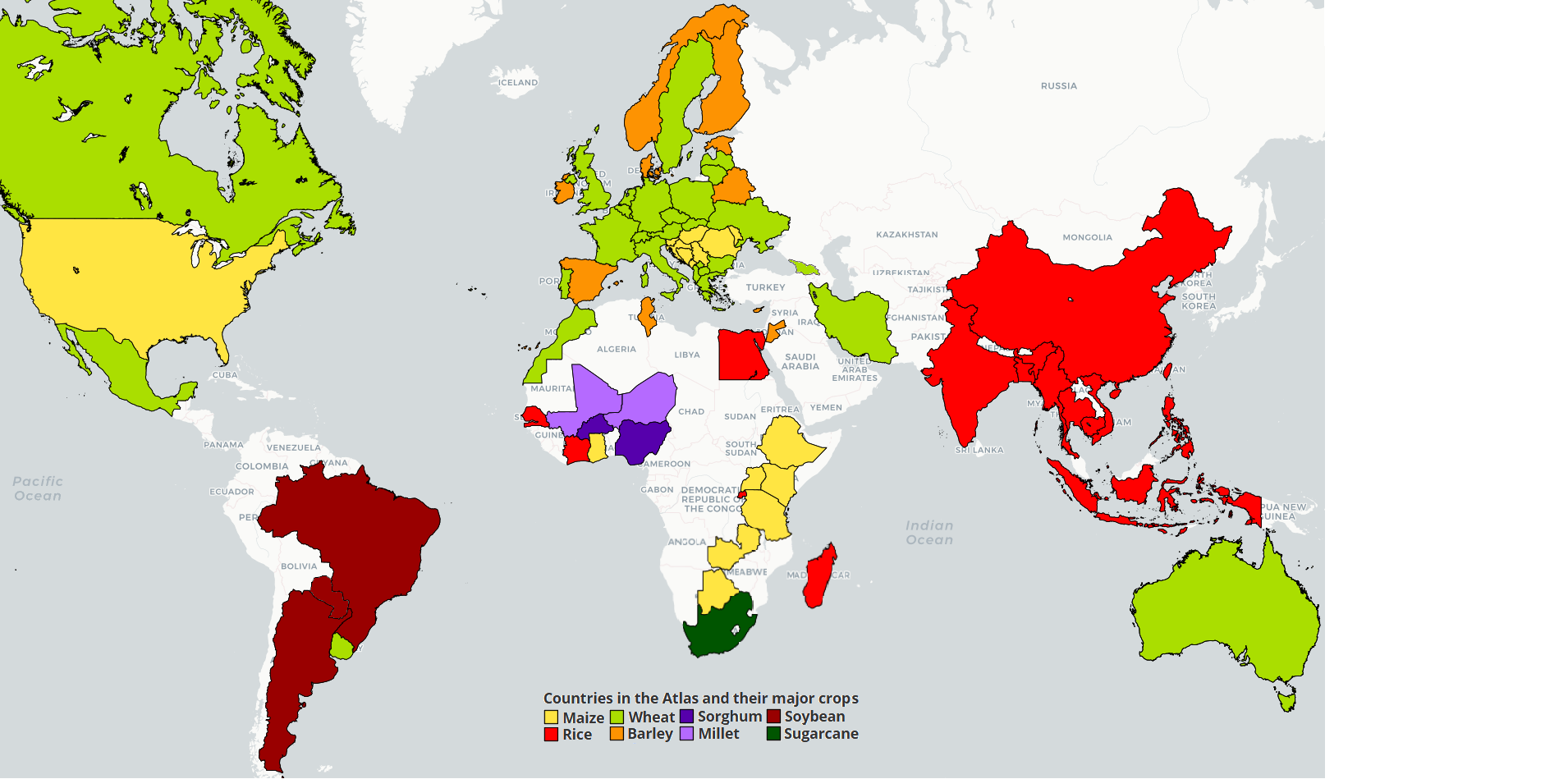 Ethiopia
Ethiopia
Detailed information on the analysis by crop is available for:
- Maize. Please check the sub-Saharan Africa maize page
- Rice. Please check the sub-Saharan Africa rice page
- Wheat. Please check the sub-Saharan Africa wheat page
- Sorghum. Please check the sub-Saharan Africa sorghum page
- Millet. Please check the sub-Saharan Africa millet page
Description of cropping systems, climate, and soils in Ethiopia (by Dr. K. Tesfaye Fantaye)
Ethiopia, situated in the Horn of Africa, has a population of nearly 110 million and a surface area of 1.2 million square kilometers, of which 65% is suitable for arable farming. Agriculture is the country's largest economic sector, contributing about 43% of the country's GDP and employing more than 85% of the working population. Production systems are dominated by smallholder farming under rainfed conditions with little mechanization. Subsistence mixed farming with crop cultivation and livestock husbandry is practiced on most farms. Agriculture is highly dependent on rainfall, and hence the onset, duration, amount and distribution of the rainfall determines the performance of the agriculture sector and the economy of the country in general. More than 95% of the country's agricultural output is generated by subsistence farmers who, on average, own less than 1 ha of cultivated land with poor soil fertility as a result of continuous cropping and little input of nutrients to replace removal with harvest.
Ethiopia is known for its ecological diversity that ranges from tropical to temperate conditions. Altitude ranges from -126 meters below sea level in the Danakil Depression in the northeast to 4620 meters above sea level in the Ras Dashen Mountains in the northwest. In central highland plateaus, where major cereal crops are grown, elevation ranges from 1800 to 3000 meters above sea level with mean annual rainfall ranging from 950-1500 mm and mean annual temperature from 11-21°C. Ecological and socio-cultural diversity creates favorable conditions to support tremendous diversity of fauna and flora such that the country is a center of origin and biodiversity for many cultivated crops and their wild relatives. According to global agroecological zone classification based on length of growing period (IIASA/FAO, 2010), the major crop growing areas of the country are found in the sub-humid, humid and moist-semiarid climatic zones. On the other hand, the Ministry of Agriculture and Rural Development (MoARD, 2005) classified the country into 32 major agro-ecological zones and categorized about 51% of the total land area of the country under arid, semi-arid and sub-moist zones and the other half in moist to humid zones. From among 18 major soil types, Nitosols (23%), Cambisols (19%), and Vertisols (18%) comprise more than half the arable land area in the different agroecologies of the country (Paulos, 2001).
About 15% of the county's area is currently used for the production of major food crops. Major staple crops include cereals, pulses, oilseeds, roots and tubers, vegetables and coffee. According to the recent Ethiopian Central Statistical Agency report (CSA, 2016), grain crops (cereals, pulses and oil crops) are cultivated on 12.5 Mha with annual production of 26.7 million metric tonnes (MMt). According to the same report, cereals, pulses and oil crops constituted 80, 13, 7% of the cultivated area and 87, 10 and 3% the total grain production of the country, respectively in the main rainy season of 2015/2016. Cereals are the most important field crops and the chief element in the diet of most Ethiopians. Principal cereals are tef (an indigenous principal staple crop), wheat, barley, maize, sorghum and millet. Wheat is grown mostly between 1,500 and 2,700 meters above sea level whereas maize, sorghum and millet are cultivated at lower elevations in the warmer areas of the country. Sorghum and millet, which are drought resistant, are grown in regions with low and uncertain rainfall. Maize is mainly grown between 1,500 and 2,200 meters above sea level and requires relatively higher seasonal rainfall to ensure good harvests. These major food crops are produced in almost all regions of the country but with large variations in terms of volume of production.
The area coverage of maize, wheat, sorghum and finger millet account for 49% of cultivated grain crop area of the country in the 2015/16 cropping season (Table 1 & 2). However, the productivity of these crops is very low despite their large production area. National average yields for maize, wheat and sorghum, and finger millet are 3.4, 2.5, 2.3 and 2.0 t ha-1, respectively in 2015/2016 (Table 2). Available evidence suggests that yields of major crops under farmers' management are still far lower than what can be obtained under on-station and on-farm research managed plots (Table 2). This is a clear indication of large yield gaps. There are several factors believed to contribute to the low productivity including, among others, moistures stress, shortage of seeds for improved varieties, soil fertility degradation, insect pests, diseases, weeds and birds.
The most important cereal farming system zones are located in the north, northwestern, central, eastern and southwestern highlands (USAID, 2010). Cereal mixed farming dominates the northern, northwestern and central highlands while maize-sorghum based cropping dominates the eastern highlands. Whilst Barley-wheat cropping dominates the Arsi and Bale highlands, coffee, maize and horticultural crops farming characterize the major farming system of the southern and southwestern highlands. The lowlands (areas below 1500 m above sea level) areas also grow short maturing maize, sorghum, wheat, and tef varieties along with some oil crops and lowland pulses.
Table 1. Area coverage of cereal crops in Ethiopia over a course of 5 decades
|
| Tef | Wheat | Maize | Sorghum | Barley | Finger Millet# | Other cereals | Total |
|---|---|---|---|---|---|---|---|---|
|
| Cereal cultivated area (M ha) | |||||||
| 1961/62-1969/70 | 2.11 | 0.97 | 0.8 | 1.09 | 0.96 | - | 0.3 | 6.23 |
| 1970/71-1979/80 | 1.67 | 0.78 | 0.83 | 0.87 | 0.84 | - | 0.27 | 5.25 |
| 1980/81-1989/90 | 1.23 | 0.52 | 0.84 | 0.71 | 0.86 | - | 0.15 | 4.3 |
| 1990/91-1999/00 | 1.76 | 0.75 | 1.12 | 0.95 | 0.73 | - | 0.29 | 5.6 |
| 2000/01-2008/09 | 2.17 | 1.27 | 1.59 | 1.35 | 0.96 | - | 0.38 | 7.72 |
| 2012/2013 | 2.73 | 1.63 | 2.01 | 1.71 | 1.02 | 0.43 | 0.08 | 9.6 |
| 2015/2016 | 2.87 | 1.66 | 2.11 | 1.85 | 0.94 | 3.7 | 0.07 | 9.97 |
|
| Area share from total cereal cultivated area (%) | |||||||
| 1961/62-1969/70 | 33.9 | 15.6 | 12.8 | 17.4 | 15.4 | - | 4.9 | 100 |
| 1970/71-1979/80 | 31.8 | 14.8 | 15.7 | 16.6 | 15.9 | - | 5.1 | 100 |
| 1980/81-1989/90 | 28.7 | 12.0 | 19.5 | 16.4 | 19.9 | - | 3.4 | 100 |
| 1990/91-1999/00 | 31.3 | 13.4 | 20.0 | 17.0 | 13.1 | - | 5.2 | 100 |
| 2000/01-2008/09 | 28.1 | 16.5 | 20.6 | 17.5 | 12.5 | - | 4.9 | 100 |
| 2012/2013 | 28.4 | 17.8 | 20.9 | 16.9 | 10.6 | 4.5 | 0.8 | 100 |
| 2015/2016 | 23.0 | 13.3 | 16.9 | 14.9 | 7.6 | 3.7 | 0.5 | 100 |
Source: Alemayehu et al, 2011 (1961/62-1979/80 data are from FAO. 1980/81 – 2008/09, 2012/13, 2015/16 data are from CSA Agricultural Sample Surveys), #Finger millet data from 1961/62-2008/09 were included in the column of other cereals.
Table 2. Nationally reported average yields compared to yields reported from on-station and on-farm experiments
| Crop | Area (M ha)* | Total Production (MMT)* | National Average Yield (t/ha)* | On-station yield (t/ha) # | On-farm yield (t/ha) # | Varieties considered for on-station and on-farm reports |
| Maize | 2.11 | 7.15 | 3.39 | 9.0-12.0 | 6.0-8.0 | BH-660 |
| Wheat | 1.66 | 4.22 | 2.54 | 3.5-5.5 | 2.5-5.0 | Dendea |
| Sorghum | 1.85 | 4.32 | 2.33 | 4.2 | 3.3 | Chare |
| Finger millet | 0.47 | 0.94 | 2.02 | 3.1 | 2.8-2.9 | Tadesse |
Source: * MMT = million metric tonnes, from CSA (2016) report; # from MoARD (1995-2011) crop variety register books
References
Alemayehu Seyoum Taffesse, Paul Dorosh and Sinafikeh Asrat. 2011. Crop Production in Ethiopia: Regional Patterns and Trends. Development Strategy and Governance Division, International Food Policy Research Institute, Ethiopia Strategy Support Program II, Ethiopia. ESSP II Working Paper No. 016.
CSA (Central Statistics Agency). 2016. Agricultural Sample Survey 2015/2016 (2008 E.C.). Volume I. Report on Area and Production of Major Crops (Private Peasant Holdings, Meher Season). Statistical Bulletin 584, Addis Ababa
CSA (Central Statistics Agency). 2013. Agricultural Sample Survey 2012/2013 (2005 E.C.). Volume I. Report on Area and Production of Major Crops (Private Peasant Holdings, Meher Season). Statistical Bulletin 532, Addis Ababa
CSA (Central Statistics Agency). 2012. Agricultural Sample Survey 2011/2012 (2004 E.C.). Volume IV. Report on Land Utilization (Private Peasant Holdings, Meher Season). Statistical Bulletin 532, Addis Ababa
FAO (Food and Agriculture Organization of the United Nations).
IIASA/FAO, 2010. Global Agro-ecological Zones (GAEZ v3.0). IIASA, Laxenburg, Austria and FAO, Rome, Italy.
MoARD (Ministry of Agriculture and Rural Development). 2005. Major Agro-ecological Zones of Ethiopia. Forestry, Land Use and Soil Conservation Department. Addis Ababa, Ethiopia.
MoARD (Ministry of Agriculture and Rural Development).1998-2011. Crop Variety Registers. Addis Ababa, Ethiopia.
Paulos Dubale. 2001. Soil and Water Resources and Degradation Factors Affecting their Productivity in the Ethiopian Highland Agro-ecosystems. International Conference on the Contemporary Development Issues in Ethiopia, CADPR, and Western Michigan University.
USAID (United States Agency for International Development). 2010. Staple Foods Value Chain Analysis. Country Report, Ethiopia. Addis Ababa.
Legume production in East Africa
Ethiopia
Common bean is a main cash crop and protein source for many farmers in Ethiopia especially in the Central Rift Valley (Mekbib 2003; Abate et al. 2011). It accounts for 23% and 20% of the total legume area and production respectively (average of 2010 – 2014, FAOSTAT). Chickpea is the second most important legume in Ethiopia, accounting for 17% and 19% of the total legume area and production respectively (FAOSTAT). Chickpea is mainly grown at an altitude of 1400-2300 m.a.s.l., where annual rainfall ranges between 700 and 2000 mm (Bejiga 1994; Anbessa and Bejiga 2002).
Approach for yield gap estimation of grain legumes in Ethiopia, Kenya and TanzaniaHarvested area and actual yields
Distribution of crop area as reported by SPAM 2005 maps (You et al., 2014a; 2014b) was used.
Actual yields for Ethiopia were based on nine year district level data obtained from the Central Statistical Agency Ethiopia (CSA-Ethiopia, 2004-2016); for Kenya a 5-year average centered on year 2005 was obtained from SPAM 2005 (You et al., 2014a; 2014b); and for Tanzania four years (2003, 2008, 2013, 2015) of district level data from the National Bureau of Statistics Tanzania were used (NBS-Tanzania, 2012; 2016a; 2016b).
Selected climate zones and Reference Weather Stations (RWS)
In our set of 3 countries, there were 14, 22, 11, 10 and 13 buffers selected for, in the same order, chickpea, common bean, cowpea, groundnut and pigeonpea. In turn, these buffers were located in, respectively, 6, 11, 7, 6, and 6 different climate zones, which, overall, accounted for respectively 52, 43, 75, 89, and 70% of east Africa harvested area with these crops.
Weather data
In the selected buffers, long-term (1998-2012) daily weather data were retrieved from the National Meteorology Agency of Ethiopia (NMA, 1998-2012), Tanzania Meteorological Agency (TMA, 1998-2012), and Kenya Meteorological Department (KMD, 1998-2012). Since 52% of the buffers had less than 10 years of weather data but at least 3 years, long weather data records were generated using the method described by Van Wart et al. (2015). Finally, for buffer zones without any measured weather data (48% of total buffers), we used uncorrected gridded weather data from NASA-POWER.
Soil data
Soil data were retrieved from both AfSIS-GYGA functional soil information of sub-Saharan Africa database (maximum effective depth of water extraction from soil by roots, maximum soil depth, volumetric soil water content available for extraction by crop roots) (Leenaars et al., 2015; Leenaars et al., 2018) and ISRIC-World soil information, WISE international soil profile dataset (drainage) (Batjes, 2012).
Crop modelling
Water-limited potential yields were estimated using the generic crop growth model Simple Simulation Model for legumes (SSM-legumes) (Soltani and Sinclair, 2012; https://sites.google.com/site/cropmodeling/-7-ssm-soybean). The SSM model has been used to simulate growth and yield potential of a wide range of legume crops, including soybean (Sinclair et al., 2014; Sinclair et al., 2010), chickpea (Soltani and Sinclair, 2011; Vadez et al., 2013), common bean (Marrou et al., 2014), lentil (Ghanem et al., 2015), cowpea (Hissene et al., 2016), and groundnut (Halilou et al., 2016).
We collected the value of general plant parameters from previous model applications (Sinclair et al., 2010, 2014; Soltani and Sinclair, 2011; Vadez et al., 2013; Marrou et al., 2014; Ricaurte et al 2015; Guiguitant et al., 2017; Manandhar et al., 2017). In each of these studies, genotypes have been sampled to represent the diversity of genotypes used in each study environment, covering temperate, dry tropical, and humid tropical climates. Most plant parameters are known from preceding studies not to vary significantly within species. For the crop specific parameters, phenology and photoperiod sensitivity, we calculated them to portray the varieties grown in east Africa, by using the parameter values of genotypes of the same variety in preceding studies, or calculating them from the phenology reported by local agronomists.
More details and references are presented in: Loon, Marloes P. van , Nanyan Deng, Patricio Grassini, Juan I. Rattalino Edreira, Endalkachew Wolde-meskel, Frederick Baijukya, Hélène Marrou, Martin K. van Ittersum. 2018. Prospect for increasing grain legume crop production in East Africa. European Journal of Agronomy. Vol. 101 (November 2018), 140-148; https://doi.org/10.1016/j.eja.2018.09.004
Get access to the Atlas for advanced users
Download GYGA results
 | Please read the license information in case you are interested in using the data from the Global Yield Gap Atlas. |
| read more>> |
 Country agronomist
Country agronomist

Kindie Tesfaye
Centro Internacional de Mejoramiento de Maíz y Trigo (CIMMYT)

Endalkachew Woldemeskel

